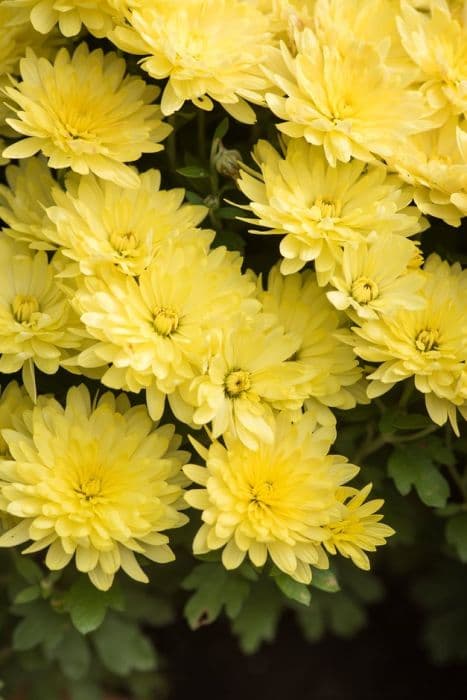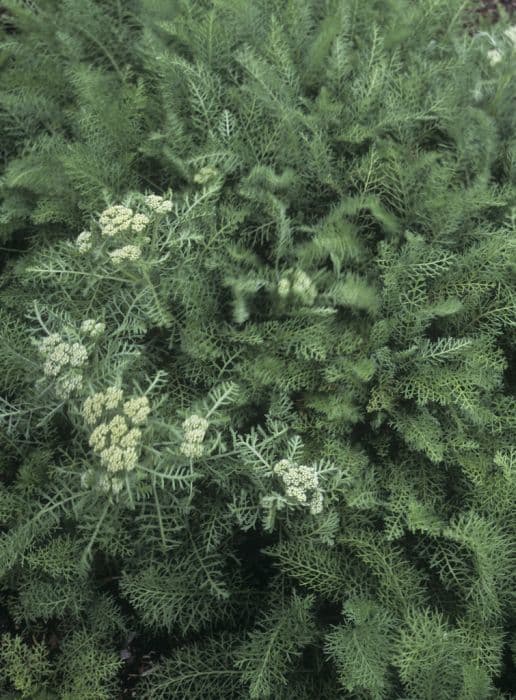Chrysanthemum Chrysanthemum 'Aluga Yellow' (PBR)

ABOUT
The Chrysanthemum 'Aluga Yellow' (PBR), commonly known as the Mum or Chrysanthemum, presents a vibrant and cheerful aesthetic with its distinctly yellow blooms. The flowers are a bright, sunny hue, capturing the essence of a sunny day in their color. These stunning blooms are composed of numerous petals that radiate outward, overlapping in a pattern that creates a lush, full appearance. The petals are soft to the touch and may have a velvety texture, with the outer petals presenting a slightly more relaxed pose than the tighter, more erect central petals surrounding the flower's core. The foliage of the Chrysanthemum 'Aluga Yellow' is typically a rich green, offering a striking contrast to the vivid yellow of the flowers. Leaves are often deeply lobed or divided, with a serrated edge, giving them a somewhat lacy or feathery look. The greenery forms a dense backdrop that highlights the floral display, making the yellow tones pop even more. As perennials, these Chrysanthemums will return each year with the proper care, bringing with them their characteristic charm and color. The overall presentation of the Chrysanthemum 'Aluga Yellow' is one of warmth and exuberance, making it a popular choice for gardens, borders, and as a cheerful addition to floral displays. While the plant's exact size is not the focus here, its capacity to produce a profusion of blossoms creates a visually substantial impact wherever it grows.
About this plant
 Names
NamesFamily
Asteraceae
Synonyms
Aluga Yellow Chrysanthemum, Yellow Mum, Aluga Yellow Mum
Common names
Chrysanthemum 'Aluga Yellow' (PBR)
 Toxicity
ToxicityTo humans
Chrysanthemums, including the variety known as 'Aluga Yellow', are not typically considered highly toxic to humans. However, they can cause dermatitis in some people who have sensitive skin or allergies. If ingested, they may lead to gastrointestinal upset, such as nausea, vomiting, diarrhea, and loss of appetite. Contact with the sap or handling the plant without gloves can sometimes result in skin rashes or irritation.
To pets
Chrysanthemums contain compounds that can be toxic to pets if ingested, particularly to cats and dogs. These compounds, called pyrethrins, may cause symptoms like drooling, vomiting, diarrhea, incoordination, and dermatitis. In severe cases, ingestion can lead to more serious conditions such as depression, hyperactivity, and tremors. It is advisable to keep chrysanthemums away from pets and monitor them for any signs of poisoning if they have been exposed to the plant.
 Characteristics
CharacteristicsLife cycle
Perennials
Foliage type
Deciduous
Color of leaves
Green
Flower color
Yellow
Height
2 feet (60 cm)
Spread
2 feet (60 cm)
Plant type
Herb
Hardiness zones
5
Native area
Asia
Benefits
 General Benefits
General Benefits- Vibrant Color: Adds striking yellow color to gardens and landscapes that can brighten up any space.
- Long Blooming Season: Typically has a lengthy flowering period, providing color over an extended time.
- Attracts Pollinators: Draws in beneficial insects like bees and butterflies, supporting biodiversity.
- Easy to Grow: Known for its hardiness and ease of cultivation, making it suitable for gardeners of all levels.
- Drought Tolerance: Once established, it can withstand periods of low water, reducing the need for frequent irrigation.
- Low Maintenance: Requires minimal care, such as occasional deadheading to promote further blooming.
- Versatile Planting: Suitable for container gardening, borders, and as cut flowers in floral arrangements.
- Frost Resistance: Can survive in colder temperatures, making it a good choice for a variety of climates.
 Medical Properties
Medical PropertiesThis plant is not used for medical purposes.
 Air-purifying Qualities
Air-purifying QualitiesThis plant is not specifically known for air purifying qualities.
 Other Uses
Other Uses- Photography Prop: The vivid yellow color of chrysanthemums adds a vibrant pop to floral photography and can be used to create visually striking compositions.
- Edible Garnish: While not commonly known as an edible, chrysanthemum petals of certain varieties can be used as a colorful garnish for salads and desserts, adding a unique flavor and visual appeal.
- Artistic Inspiration: Chrysanthemums have long inspired artists and can be used as a muse for paintings, illustrations, and textile designs due to their intricate patterns and diversity of colors.
- Natural Dyes: The petals of chrysanthemums can be used to create natural dyes for fabric, yarn, or paper, lending a soft yellow hue to the materials.
- Bioindicator: Chrysanthemums can sometimes be used as bioindicators to detect environmental changes or pollution by observing changes in their growth, flowering patterns, or foliage health.
- Ceremonial Decor: In various cultures, chrysanthemums are used in ceremonies, such as weddings or festivals, as they symbolize joy and longevity.
- Craft Projects: Dried chrysanthemum flowers can be used in craft projects, such as potpourri, wreaths, or as inclusions in handmade paper.
- Bookmarks: Pressed chrysanthemum flowers can be laminated and used as delicate and personalized bookmarks.
- Fragrance Extraction: Although not as common as other flowers, chrysanthemum scent can be extracted and used in homemade perfumes or aromatherapy oils.
- Fish Tanks: After ensuring they are safe and free of pesticides, chrysanthemum leaves can be placed in fish tanks to add a natural and colorful element to the aquatic environment.
Interesting Facts
 Feng Shui
Feng ShuiThe chrysanthemum, known for its properties of purification and protection, can be used in Feng Shui to attract positive energy into the home. Place yellow chrysanthemums in the center of your space or in the Health area (center) of the Bagua map to promote balance and health, as yellow is synonymous with the Earth element and represents stability and nurturing.
 Zodiac Sign Compitability
Zodiac Sign CompitabilityThe chrysanthemum is not used in astrology practice.
 Plant Symbolism
Plant Symbolism- Longevity: Chrysanthemums are often associated with long life and health, reflecting the plant's ability to bloom well into the autumn while other plants are fading.
- Rejuvenation: Because they bloom in the fall, chrysanthemums symbolize the ability to withstand challenges and bounce back.
- Nobility: In Asian cultures, the chrysanthemum is considered a noble flower, often associated with honesty and integrity.
- Loyalty: The flower is frequently given to represent fidelity and devotion in relationships, stemming from its ability to bloom year after year.
- Death: In several European cultures, chrysanthemums are symbolic of death and are often used for funerary arrangements or memorials.
- Joy: Despite some somber associations, these flowers are also known to symbolize joy and happiness in many cultures due to their bright and cheerful appearance.
 Water
WaterMums, the common name for Chrysanthemum 'Aluga Yellow', prefer evenly moist soil when active growth is present, typically from spring to fall. They require watering approximately every other day, though this may vary depending on the climate and soil type. When watering, it's important to water deeply and directly at the base, to encourage deep root growth and avoid wetting the foliage. Approximately one gallon of water per week is suitable for a mature plant, adjusted for rainfall and temperatures. Avoid over-watering, as mums do not like soggy soil, which can lead to root rot.
 Light
LightMums thrive in full sun to partial shade. An ideal spot for Chrysanthemum 'Aluga Yellow' would be a location where it can receive at least 6 hours of direct sunlight daily. However, in extremely hot climates, they benefit from afternoon shade to prevent scorching of the leaves. Ensure that the plant is not shaded by larger plants to maintain the health and vibrancy of the blooms.
 Temperature
TemperatureMums do best in cooler conditions and can tolerate temperatures down to about 32 degrees Fahrenheit without damage. Chrysanthemum 'Aluga Yellow' prefers a temperature range between 55 and 75 degrees Fahrenheit for optimal growth. It is vital to protect the plant from extreme heat and frost, which can be detrimental to its health and blooming potential.
 Pruning
PruningPruning mums promotes bushier growth and more abundant blooms. Chrysanthemum 'Aluga Yellow' should be pinched back when new shoots are 4 to 6 inches tall, ideally in late spring to early summer. Repeat this process every two to three weeks until mid-July to encourage branching. The best time for heavy pruning is after the flowering season, usually in late fall, to prepare plants for the next year's growth.
 Cleaning
CleaningAs needed
 Soil
SoilMums like well-draining, fertile soil with a pH between 6.0 and 7.0. A recipe for the best soil mix for Mums might include equal parts peat, perlite, and loamy garden soil.
 Repotting
RepottingMums (Chrysanthemums) should be repotted every one to two years to refresh the soil and to accommodate the growing root system.
 Humidity & Misting
Humidity & MistingMums prefer moderate humidity levels, typically between 40% to 60%, which will help maintain their health without promoting fungal diseases.
 Suitable locations
Suitable locationsIndoor
Place in bright, indirect light and ensure good air circulation for Mums.
Outdoor
Plant in well-draining soil, full sun to partial shade for Mums.
Hardiness zone
5-9 USDA
 Life cycle
Life cycleThe Chrysanthemum 'Aluga Yellow', commonly known as a type of hardy garden mum or florists' daisy, begins its life cycle as a seed or cutting, which when planted, germinates or roots to form a new plant. During the vegetative stage, the plant develops a robust root system and foliage, growing leaves and stems until it reaches maturity. With proper conditions of light and temperature, the chrysanthemum enters the budding stage, where flower buds start to form and develop. The flowering stage follows, showcasing the plant's bright yellow blooms that attract pollinators and are key for its reproduction. After flowering, chrysanthemums produce seeds that disperse, completing the sexual reproductive cycle, or they can be propagated vegetatively through cuttings. Once the blooming period ends and temperatures drop in late fall or winter, the plant enters dormancy, conserving energy and resources to survive until the next growing season.
 Propogation
PropogationPropogation time
Spring-Early Summer
The Chrysanthemum 'Aluga Yellow', often referred to as mums, is typically propagated by cuttings. This is the most popular method as it ensures that the new plants will bear flowers identical to the parent plant. To propagate by cuttings, a healthy, non-flowering shoot is selected and a piece about 4 to 6 inches (10 to 15 centimeters) long is cut. The lower leaves are removed, and the cut end is dipped into rooting hormone powder to encourage root development. The cutting is then placed in well-draining soil, watered gently, and kept under high humidity and indirect light until roots have established, which usually takes about 4 to 6 weeks. After rooting, the new mums can be transplanted to a more permanent location.









